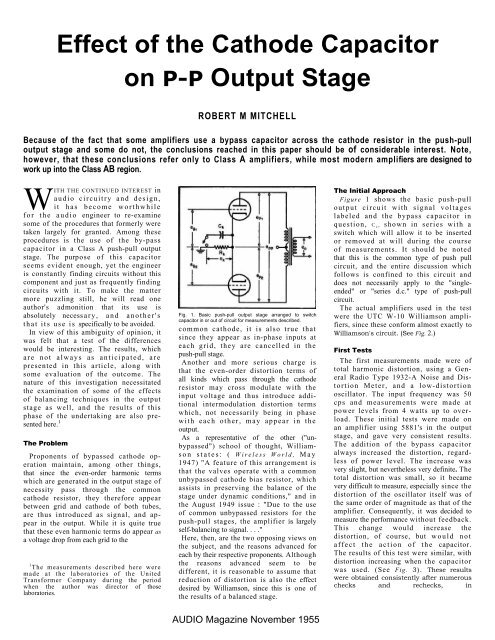Effects of the Cathode Capacitor on P-P Output Stage - Tube CAD ...
Effects of the Cathode Capacitor on P-P Output Stage - Tube CAD ...
Effects of the Cathode Capacitor on P-P Output Stage - Tube CAD ...
Create successful ePaper yourself
Turn your PDF publications into a flip-book with our unique Google optimized e-Paper software.
Fig. 4. Same measurements as Fig. 3 withdifferent pair <str<strong>on</strong>g>of</str<strong>on</strong>g> tubes in <str<strong>on</strong>g>the</str<strong>on</strong>g> amplifier.These curves are plotted a different scale.equal to <str<strong>on</strong>g>the</str<strong>on</strong>g> sum and difference <str<strong>on</strong>g>of</str<strong>on</strong>g> <str<strong>on</strong>g>the</str<strong>on</strong>g>two input frequencies, or <str<strong>on</strong>g>of</str<strong>on</strong>g> <strong>on</strong>e inputand harm<strong>on</strong>ics <str<strong>on</strong>g>of</str<strong>on</strong>g> <str<strong>on</strong>g>the</str<strong>on</strong>g> o<str<strong>on</strong>g>the</str<strong>on</strong>g>r, etc. Thisacti<strong>on</strong> is <str<strong>on</strong>g>the</str<strong>on</strong>g> basis <str<strong>on</strong>g>of</str<strong>on</strong>g> our comm<strong>on</strong> system<str<strong>on</strong>g>of</str<strong>on</strong>g> amplitude modulati<strong>on</strong>, where <str<strong>on</strong>g>the</str<strong>on</strong>g> producti<strong>on</strong><str<strong>on</strong>g>of</str<strong>on</strong>g> such sidebands is a necessary feature <str<strong>on</strong>g>of</str<strong>on</strong>g><str<strong>on</strong>g>the</str<strong>on</strong>g> process. In <str<strong>on</strong>g>the</str<strong>on</strong>g> comm<strong>on</strong>ly used (andmost familiar) method <str<strong>on</strong>g>of</str<strong>on</strong>g> intermodulati<strong>on</strong>tests, a high-frequency t<strong>on</strong>e (<str<strong>on</strong>g>the</str<strong>on</strong>g> carrier) ismodulated by a low-frequency t<strong>on</strong>e, and<str<strong>on</strong>g>the</str<strong>on</strong>g> resulting side-bands detected andmeasured by a suitable circuit.Although this method is an excellentindicati<strong>on</strong> <str<strong>on</strong>g>of</str<strong>on</strong>g> n<strong>on</strong>linearity which generallycorrelates closely with listening tests, itwas found that ano<str<strong>on</strong>g>the</str<strong>on</strong>g>r method gaveresults which sometimes seemed to correlateeven more closely. This sec<strong>on</strong>dmethod <str<strong>on</strong>g>of</str<strong>on</strong>g> intermodulati<strong>on</strong> distorti<strong>on</strong>measurement also utilizes <str<strong>on</strong>g>the</str<strong>on</strong>g> fact thatdifference frequencies are produced. In thismethod, generally called <str<strong>on</strong>g>the</str<strong>on</strong>g> CCIFmethod, two high-frequency t<strong>on</strong>es <str<strong>on</strong>g>of</str<strong>on</strong>g>equal amplitude and separated in frequencyby a fixed amount. are applied to<str<strong>on</strong>g>the</str<strong>on</strong>g> device under test. The output ismeasured by a wave analyzer tuned to<strong>on</strong>e <str<strong>on</strong>g>of</str<strong>on</strong>g> <str<strong>on</strong>g>the</str<strong>on</strong>g> distorti<strong>on</strong> frequencies such as f2– f1, 2f2– f1 or 2f1 – f2, and <str<strong>on</strong>g>the</str<strong>on</strong>g> distorti<strong>on</strong>voltage is expressed as a percentage<str<strong>on</strong>g>of</str<strong>on</strong>g> <str<strong>on</strong>g>the</str<strong>on</strong>g> sum <str<strong>on</strong>g>of</str<strong>on</strong>g> <str<strong>on</strong>g>the</str<strong>on</strong>g> two input voltages.Figure 6 shows <str<strong>on</strong>g>the</str<strong>on</strong>g> two types <str<strong>on</strong>g>of</str<strong>on</strong>g> intermodulati<strong>on</strong>in graphic form. One noticeablefeature <str<strong>on</strong>g>of</str<strong>on</strong>g> <str<strong>on</strong>g>the</str<strong>on</strong>g> CCIF type is <str<strong>on</strong>g>the</str<strong>on</strong>g>locati<strong>on</strong> <str<strong>on</strong>g>of</str<strong>on</strong>g> <str<strong>on</strong>g>the</str<strong>on</strong>g> difference-frequency comp<strong>on</strong>entf1 – f2. Since this comp<strong>on</strong>ent is s<str<strong>on</strong>g>of</str<strong>on</strong>g>ar removed from <str<strong>on</strong>g>the</str<strong>on</strong>g> two input frequencies,<str<strong>on</strong>g>the</str<strong>on</strong>g>re is less tendency for <str<strong>on</strong>g>the</str<strong>on</strong>g> signalto mask <str<strong>on</strong>g>the</str<strong>on</strong>g> distorti<strong>on</strong> as <str<strong>on</strong>g>the</str<strong>on</strong>g>re might bein <str<strong>on</strong>g>the</str<strong>on</strong>g> SMPTE method, or in <str<strong>on</strong>g>the</str<strong>on</strong>g> CCIFmethod for <str<strong>on</strong>g>the</str<strong>on</strong>g> 2f1 – f2. and 2f2– f1 terms.This difference t<strong>on</strong>e is particularly objecti<strong>on</strong>ablewhen it falls in <str<strong>on</strong>g>the</str<strong>on</strong>g> regi<strong>on</strong> <str<strong>on</strong>g>of</str<strong>on</strong>g>maximum sensitivity <str<strong>on</strong>g>of</str<strong>on</strong>g> <str<strong>on</strong>g>the</str<strong>on</strong>g> ear (400 to5000 cps), and is noticeable in amounts assmall as a fracti<strong>on</strong> <str<strong>on</strong>g>of</str<strong>on</strong>g> <strong>on</strong>e per cent.It must be pointed out, however, thatdue to <str<strong>on</strong>g>the</str<strong>on</strong>g> difference in method <str<strong>on</strong>g>of</str<strong>on</strong>g> expressingpercentages in <str<strong>on</strong>g>the</str<strong>on</strong>g> two methods, equivalentpercentages are not indicative <str<strong>on</strong>g>of</str<strong>on</strong>g>equivalent degrees <str<strong>on</strong>g>of</str<strong>on</strong>g> n<strong>on</strong>linearity. TheSMPTE values appear relatively highwhile <str<strong>on</strong>g>the</str<strong>on</strong>g> CCIF values appear relativelylow for <str<strong>on</strong>g>the</str<strong>on</strong>g> same n<strong>on</strong>linearity. 2In using <str<strong>on</strong>g>the</str<strong>on</strong>g> CCIF method <str<strong>on</strong>g>of</str<strong>on</strong>g> measurementtwo procedures are comm<strong>on</strong>ly used.One is to select two fixed inputfrequencies and measure <str<strong>on</strong>g>the</str<strong>on</strong>g> distorti<strong>on</strong>as <str<strong>on</strong>g>the</str<strong>on</strong>g> power output is varied. The o<str<strong>on</strong>g>the</str<strong>on</strong>g>ris to select a fixed power output level andto vary <str<strong>on</strong>g>the</str<strong>on</strong>g> two input frequenciessimultaneously, maintaining a c<strong>on</strong>stantdifference frequency. The first isra<str<strong>on</strong>g>the</str<strong>on</strong>g>r readily accomplished, whereas <str<strong>on</strong>g>the</str<strong>on</strong>g>sec<strong>on</strong>d requires ei<str<strong>on</strong>g>the</str<strong>on</strong>g>r a special oscillatorsuch as <str<strong>on</strong>g>the</str<strong>on</strong>g> General Radio 1303-A, ortwo oscillators calibrated with sufficient ac-Fig. 5. Comparative distorti<strong>on</strong>s withdifferent types <str<strong>on</strong>g>of</str<strong>on</strong>g> tubes in <str<strong>on</strong>g>the</str<strong>on</strong>g> output stageshow different results.curacy to enable <str<strong>on</strong>g>the</str<strong>on</strong>g> difference to bereadily distinguished from <str<strong>on</strong>g>the</str<strong>on</strong>g> dial settings.The stock oscillator in <str<strong>on</strong>g>the</str<strong>on</strong>g> UTClaboratories is a decade-type oscillatorwith an accuracy <str<strong>on</strong>g>of</str<strong>on</strong>g> four places, andc<strong>on</strong>sequently is ideally suited to any suchapplicati<strong>on</strong>.Two such oscillators are used with <str<strong>on</strong>g>the</str<strong>on</strong>g>simple mixer-potentiometer circuit shown inFig. 7 to provide c<strong>on</strong>trol <str<strong>on</strong>g>of</str<strong>on</strong>g> frequency andoutput <str<strong>on</strong>g>of</str<strong>on</strong>g> ei<str<strong>on</strong>g>the</str<strong>on</strong>g>r oscillator and <str<strong>on</strong>g>the</str<strong>on</strong>g> overallvoltage output. The isolating resistornetworks prevent any interacti<strong>on</strong>,2A discussi<strong>on</strong> <str<strong>on</strong>g>of</str<strong>on</strong>g> <str<strong>on</strong>g>the</str<strong>on</strong>g> two methods <str<strong>on</strong>g>of</str<strong>on</strong>g>intermodulati<strong>on</strong> distorti<strong>on</strong> measurementwill be found in <str<strong>on</strong>g>the</str<strong>on</strong>g> General Radio CompanyTechnical Publicati<strong>on</strong> B-3, The Measurement<str<strong>on</strong>g>of</str<strong>on</strong>g> N<strong>on</strong>-linear Distorti<strong>on</strong>, by Arnold Peters<strong>on</strong>.Fig. 7. Method <str<strong>on</strong>g>of</str<strong>on</strong>g> c<strong>on</strong>necting two audiooscillators to provide CCIF type <str<strong>on</strong>g>of</str<strong>on</strong>g> IM signal—without introducing intermodulati<strong>on</strong>in <str<strong>on</strong>g>the</str<strong>on</strong>g> mixing circuit.and c<strong>on</strong>sequent intermodulati<strong>on</strong> between<str<strong>on</strong>g>the</str<strong>on</strong>g> two oscillators.The CCIF intermodulati<strong>on</strong> tests wereperformed using both methods menti<strong>on</strong>edabove. When distorti<strong>on</strong> was measured as afuncti<strong>on</strong> <str<strong>on</strong>g>of</str<strong>on</strong>g> power level, <str<strong>on</strong>g>the</str<strong>on</strong>g> followingrelati<strong>on</strong>s were taken into c<strong>on</strong>siderati<strong>on</strong> :Since two frequencies are involved, acomplex (n<strong>on</strong>-sinusoidal) wave is produced,and <str<strong>on</strong>g>the</str<strong>on</strong>g> indicati<strong>on</strong> <str<strong>on</strong>g>of</str<strong>on</strong>g> an ordinaryvacuum tube voltmeter is, <str<strong>on</strong>g>the</str<strong>on</strong>g>refore, notvalid in determining <str<strong>on</strong>g>the</str<strong>on</strong>g> power level by<str<strong>on</strong>g>the</str<strong>on</strong>g> customary formula P=E 2 /R. Fur<str<strong>on</strong>g>the</str<strong>on</strong>g>rmore,since <strong>on</strong>e wave rides <str<strong>on</strong>g>the</str<strong>on</strong>g> o<str<strong>on</strong>g>the</str<strong>on</strong>g>r,<str<strong>on</strong>g>the</str<strong>on</strong>g> peak value <str<strong>on</strong>g>of</str<strong>on</strong>g> <str<strong>on</strong>g>the</str<strong>on</strong>g> two waves mayreach a value equal to <str<strong>on</strong>g>the</str<strong>on</strong>g> algebraic sum<str<strong>on</strong>g>of</str<strong>on</strong>g> <str<strong>on</strong>g>the</str<strong>on</strong>g> individual waves, with <str<strong>on</strong>g>the</str<strong>on</strong>g> resultthat overload can occur for two frequencieswhen each is <strong>on</strong>ly <strong>on</strong>e-half <str<strong>on</strong>g>the</str<strong>on</strong>g> amplituderequired for overload by a singlefrequency. (See Fig. 8) Since each wave is<strong>on</strong>ly <strong>on</strong>e-half <str<strong>on</strong>g>the</str<strong>on</strong>g> maximum amplitude, itcan produce <strong>on</strong>ly <strong>on</strong>e-quarter <str<strong>on</strong>g>the</str<strong>on</strong>g>power <str<strong>on</strong>g>of</str<strong>on</strong>g> a single maximum-amplitudewave. The power available from two suchwaves without any possibility <str<strong>on</strong>g>of</str<strong>on</strong>g> overloadis, <str<strong>on</strong>g>the</str<strong>on</strong>g>refore, <strong>on</strong>ly <strong>on</strong>e-half <str<strong>on</strong>g>the</str<strong>on</strong>g>power available from a single-frequencywave. The curves for <str<strong>on</strong>g>the</str<strong>on</strong>g> CCIF intermodulati<strong>on</strong>tests are calibrated in terms <str<strong>on</strong>g>of</str<strong>on</strong>g>volts as read <strong>on</strong> an audio-frequencyFig. 6. Comparis<strong>on</strong> <str<strong>on</strong>g>of</str<strong>on</strong>g> frequenciespresent in two different types <str<strong>on</strong>g>of</str<strong>on</strong>g>intermodulati<strong>on</strong> measurements.
















